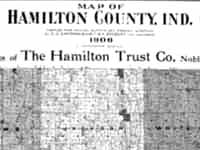
Map Locating Noblesville, Indiana |
Landownership maps and atlases were published by commercial
companies, usually on a subscription basis, for the wealthier
rural areas. Landownership atlases also documented the migration
of blacks to the Midwest. A map of Noblesville, the fifth seat
of Hamilton, County, Indiana, shows the site of the Roberts
Settlement. In 1909, Stephen Roberts Jr. (b. 1849), grandson of
Willis Roberts, the first settler, was still buying cattle in
Noblesville.
Hamilton County, Indiana
Indiana: The Hamilton Trust Company, 1906
Map
Geography and Map Division (98)
|
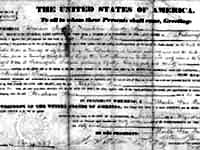
Roberts Settlement Land Grant |
Abraham Jones's 1837 land-grant certificate, signed by President
Martin Van Buren, is typical of those issued to the colonists of
the Roberts Settlement.
Land grant certificate
The Roberts Family Papers, 1734-1944
Manuscript Division (99)
|

Roberts Family Genealogical Chart |
The Roberts family chart traces the descendants of James Roberts
I of Northampton County, North Carolina, grandfather of Willis
Roberts (1782-1846) and founder of the Roberts Settlement in
Noblesville, Indiana. Willis Roberts became a prosperous farmer
and eventually married Mary Marthaline Hunt. They had eight
children born between 1803 and 1819.
Photocopy of manuscript chart
Roberts Family Papers, 1734-1944
Manuscript Division (100)
|
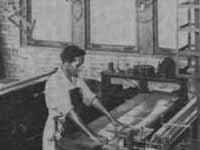
Jobs of Black Women in World War I |
During World War I, industrial opportunities became available to
women when workers were needed to replace men drafted into
military service. Black women responded to the demand by leaving
their homes and domestic jobs. This chart shows a sampling of
the industrial occupations of 21,547 black women in approximately
seventy-five specific processes, at 152 plants, during the period
December 1, 1918, to June 30, 1919. The report was made by Mrs.
Helen B. Irvin, Special Agent of the Women's Bureau on 1918-1919.
United States. Department of Labor. Division of Negro Economics.
The Negro at Work During the World War and During Reconstruction:
Statistics, Problems, and Policies Relating to the Greater
Inclusion of Negro Wage Earners in American Industry and
Agriculture, p. 125
New York: Negro Universities Press, 1969
General Collections (101)
|

Founder and Editor of the Chicago Defender |
African-American journalist Robert Sengstacke Abbott (1868-1940)
founded the Chicago Defender on May 6, 1905, with a capital
totalling twenty-five cents. His editorial creed was to fight
against "segregation, discrimination, disenfranchisement . . . ."
The Defender reached national prominence during the mass
migration of blacks from the South during World War I, when the
paper's banner headline for January 6, 1917, read "Millions to
Leave South." The Defender became the bible of many seeking "The
Promised Land." Abbott advertised Chicago so effectively that
even migrants heading for other northern cities sought
information and assistance from the pages of the "Worlds Greatest
Weekly."
Kenneth L. Kusmer, Ed.
The Great Migration and After, 1917-1930, vol. 5, p. 4
Black Communities and Urban Development in America, 1720-1990,
vol. 5
New York: Garland, 1991
General Collections (102)
|

The "Exoduster" Movement |
Benjamin "Pap" Singleton (1809-1892), a former slave born in
Nashville, Tennessee, became the leader of the "Exoduster
Movement" of 1879, and in later years he was accorded the title
"Father of the Exodus." In the late 1860s, Singleton and his
associates urged blacks to acquire farmland in Tennessee, but
whites would not sell productive land to them. As an alternative
Singleton began scouting land in Kansas in the early 1870s. Soon
several black families migrated from Nashville. By 1874,
Singleton and his associates had formed the Edgefield Real Estate
and Homestead Association in Tennessee, which steered more than
20,000 black migrants to Kansas between 1877 and 1879. In 1880
Singleton claimed to be "the whole cause of the Kansas
immigration," in testimony before a U.S. committee on the "exodus
to Kansas."
Nell Irvin Painter
Exodusters: Black Migration to Kansas After the Reconstruction,
p. 100
New York: Knopf, 1977
General Collections (103)
|
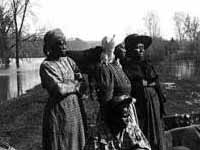
Emigrants Travelling to Kansas |
In February of 1880, more than 900 black families from
Mississippi reached St. Louis, en route to Kansas. Some black
migrants sought "conductors" to make travel arrangements for
them. These conductors would often ask for money in advance and
not show up at the appointed departure time, leaving migrants
stranded at docks and train stations.
Refugees on Levee, 1897. Carroll's Art Gallery. Photomural from gelatin-silver print Prints and Photographs Division (105)
Prints and Photographs Division (105)
|
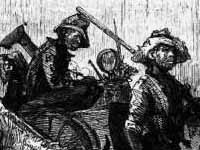
Exodusters En Route To Kansas |
At the time of the Exodus to Kansas, yellow fever ravaged many
river towns in Missouri, Mississippi, and Louisiana. Because
many of the black migrants who stopped over in these towns --
coming by steamboat, train, or horseback -- were sick, unwashed,
and poverty-stricken, it was assumed by city officials that they
must be potential disease carriers. This caused great alarm in
such cities as St. Louis, which imposed unnecessary quarantine
measures to discourage future migrants.
"Negro Exodusters en route to Kansas, fleeing from the yellow fever, " Photomural from engraving. Harpers Weekly, 1870. Historic American Building Survey Field Records, HABS FN-6, #KS -49-11
Prints and Photographs Division (106)
|

Exoduster Leaders |
In 1874 Benjamin Singleton and his associates formed the
Edgefield Real Estate and Homestead Association in Tennessee.
This association sought out the best locations for black
settlements. Singleton tried to establish a well-planned and
organized movement to Kansas, but by 1879, the unruly, mass
Exodus had overwhelmed his efforts.
Benjamin Singleton, and S.A. McClure, Leaders of the Exodus, leaving Nashville, Tennessee.
Photomural from montage. Historic American Building Survey Field Records,
HABS FN-6, #KS-49-12
Prints and Photographs Division (107)
|
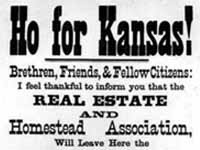
Advertisement for Kansas |
Blacks had obtained information about Kansas by several means:
letters from migrants, who settled in Nicodemus and other
locations; circulars; and mass meetings. Benjamin Singleton
printed handbills in an attempt to attract blacks to visit or
settle in Kansas. One such flier was headed: "Ho For Kansas!"
"Ho For Kansas!" Copyprint of handbill. Historic American Building Survey Field Records, HABS FN-6, #KS-49-14
Prints and Photographs Division (109) |










![[Previous]](prev.gif)
![[Next]](next.gif)
 Library of Congress
Library of Congress